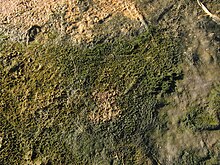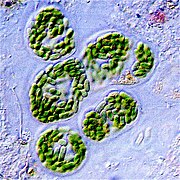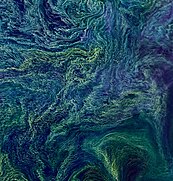해양원핵생물: 두 판 사이의 차이
편집 요약 없음 |
편집 요약 없음 |
||
| 10번째 줄: | 10번째 줄: | ||
== 역사(Evolution) == |
== 역사(Evolution) == |
||
약 4,54 억 년 전 [[지구]]에<ref name="USGS1997">{{웹 인용|url=http://pubs.usgs.gov/gip/geotime/age.html |title=Age of the Earth |date=9 July 2007 |publisher=[[United States Geological Survey]] |access-date=2015-05-31}}</ref><ref name="Dalrymple 2001 205–221">{{harvnb|Dalrymple|2001|pp=205–221}}</ref><ref name="Elsevier">{{저널 인용|last1=Manhesa |first1=Gérard |last2=Allègre |first2=Claude J. |author-link2=Claude Allègre |last3=Dupréa |first3=Bernard |last4=Hamelin |first4=Bruno |date=May 1980 |title=Lead isotope study of basic-ultrabasic layered complexes: Speculations about the age of the earth and primitive mantle characteristics |journal=[[Earth and Planetary Science Letters]] |volume=47 |issue=3 |pages=370–382 |bibcode=1980E&PSL..47..370M |doi=10.1016/0012-821X(80)90024-2 | name-list-style = vanc}}</ref> |
약 4,54 억 년 전 [[지구]]에<ref name="USGS1997">{{웹 인용|url=http://pubs.usgs.gov/gip/geotime/age.html |title=Age of the Earth |date=9 July 2007 |publisher=[[United States Geological Survey]] |access-date=2015-05-31}}</ref><ref name="Dalrymple 2001 205–221">{{harvnb|Dalrymple|2001|pp=205–221}}</ref><ref name="Elsevier">{{저널 인용|last1=Manhesa |first1=Gérard |last2=Allègre |first2=Claude J. |author-link2=Claude Allègre |last3=Dupréa |first3=Bernard |last4=Hamelin |first4=Bruno |date=May 1980 |title=Lead isotope study of basic-ultrabasic layered complexes: Speculations about the age of the earth and primitive mantle characteristics |journal=[[Earth and Planetary Science Letters]] |volume=47 |issue=3 |pages=370–382 |bibcode=1980E&PSL..47..370M |doi=10.1016/0012-821X(80)90024-2 | name-list-style = vanc}}</ref> |
||
최초의 확실한 증거는 [[생명체|지구의 생명체]] 적어도 3.5 억 년 전부터,<ref name="Origin1">{{저널 인용|last1=Schopf |first1=J. William |author-link1=J. William Schopf |last2=Kudryavtsev |first2=Anatoliy B. |last3=Czaja |first3=Andrew D. |last4=Tripathi |first4=Abhishek B. |date=5 October 2007 |title=Evidence of Archean life: Stromatolites and microfossils |journal=[[Precambrian Research]] |volume=158 |pages=141–155 |issue=3–4 |doi=10.1016/j.precamres.2007.04.009 |bibcode=2007PreR..158..141S | name-list-style = vanc}}</ref><ref name="RavenJohnson2002">{{harvnb|Raven|Johnson|2002|p=68}}</ref> 지질학적 [[지각]]이 초기 융용 [[명왕누대]]에 따라 굳어지기 시작한 후 [[초시생대]] 시기 동안부터이다. [[서호주]]에서 [[미생물 매트]] [[화석]]이 3.48 억 년 된 [[사암]]에서 발견되었다.<ref>{{저널 인용| last1 = Baumgartner | first1 = R. J. | display-authors = etal | year = 2019 | title = Nano−porous pyrite and organic matter in 3.5-billion-year-old stromatolites record primordial life | journal = Geology | volume = 47| issue = 11| pages = 1039–1043| doi = 10.1130/G46365.1 | bibcode = 2019Geo....47.1039B | s2cid = 204258554 | url = https://discovery.ucl.ac.uk/id/eprint/10087275/1/Baumgartner%20et%20al%202019%20accepted.pdf | name-list-style = vanc}}</ref><ref>[https://phys.org/news/2019-09-earliest-life-scientists-microbial-ancient.html Earliest signs of life: Scientists find microbial remains in ancient rocks] ''Phys.org''. 26 September 2019.</ref> |
최초의 확실한 증거는 [[생명체|지구의 생명체]] 적어도 3.5 억 년 전부터,<ref name="Origin1">{{저널 인용|last1=Schopf |first1=J. William |author-link1=J. William Schopf |last2=Kudryavtsev |first2=Anatoliy B. |last3=Czaja |first3=Andrew D. |last4=Tripathi |first4=Abhishek B. |date=5 October 2007 |title=Evidence of Archean life: Stromatolites and microfossils |journal=[[Precambrian Research]] |volume=158 |pages=141–155 |issue=3–4 |doi=10.1016/j.precamres.2007.04.009 |bibcode=2007PreR..158..141S | name-list-style = vanc}}</ref><ref name="RavenJohnson2002">{{harvnb|Raven|Johnson|2002|p=68}}</ref> 지질학적 [[지각]]이 초기 융용 [[명왕누대]]에 따라 굳어지기 시작한 후 [[초시생대]] 시기 동안부터이다. [[서호주]]에서 [[미생물 매트]] [[화석]]이 3.48 억 년 된 [[사암]]에서 발견되었다.<ref>{{저널 인용| last1 = Baumgartner | first1 = R. J. | display-authors = etal | year = 2019 | title = Nano−porous pyrite and organic matter in 3.5-billion-year-old stromatolites record primordial life | journal = Geology | volume = 47| issue = 11| pages = 1039–1043| doi = 10.1130/G46365.1 | bibcode = 2019Geo....47.1039B | s2cid = 204258554 | url = https://discovery.ucl.ac.uk/id/eprint/10087275/1/Baumgartner%20et%20al%202019%20accepted.pdf | name-list-style = vanc}}</ref><ref>[https://phys.org/news/2019-09-earliest-life-scientists-microbial-ancient.html Earliest signs of life: Scientists find microbial remains in ancient rocks] ''Phys.org''. 26 September 2019.</ref> |
||
[[파일:Tree of Living Organisms 2.png|섬네일|left|upright=1.3|살아있는 유기체의 계통 발생 및 공생 유전 나무, 진핵 생물과 원핵 생물의 기원에 대한 견해를 |
[[파일:Tree of Living Organisms 2.png|섬네일|left|upright=1.3|살아있는 유기체의 계통 발생 및 공생 유전 나무, 진핵 생물과 원핵 생물의 기원에 대한 견해를 보여준다.]] |
||
과거의 종들은 또한 그들의 진화 역사에 대한 기록을 남겼다. 화석은 현재 유기체의 비교 해부학과 함께 형태 학적 또는 해부학 적 기록을 구성한다.<ref name=Jablonski>{{저널 인용|last=Jablonski |first=David |date=25 June 1999 |title=The Future of the Fossil Record |journal=Science |volume=284 |issue=5423 |pages=2114–2116 |pmid=10381868 |doi=10.1126/science.284.5423.2114 |s2cid=43388925 |url=https://semanticscholar.org/paper/fe761f71c762f11618771d8c2593f9819b1472c0 | name-list-style = vanc}}</ref>현대 종과 멸종 된 종의 해부학을 비교함으로써 고생물학자들은 그 종의 혈통을 추론 할 수 있다. 그러나 이 접근법은 껍질, 뼈 또는 치아와 같은 단단한 신체 부위를 가진 유기체에 가장 성공적이다. 또한, 박테리아 및 고세균과 같은 원핵생물은 제한된 공통 형태를 공유하기 때문에, 그들의 화석은 그들의 조상에 대한 정보를 제공하지 않는다. |
과거의 종들은 또한 그들의 진화 역사에 대한 기록을 남겼다. 화석은 현재 유기체의 비교 해부학과 함께 형태 학적 또는 해부학 적 기록을 구성한다.<ref name=Jablonski>{{저널 인용|last=Jablonski |first=David |date=25 June 1999 |title=The Future of the Fossil Record |journal=Science |volume=284 |issue=5423 |pages=2114–2116 |pmid=10381868 |doi=10.1126/science.284.5423.2114 |s2cid=43388925 |url=https://semanticscholar.org/paper/fe761f71c762f11618771d8c2593f9819b1472c0 | name-list-style = vanc}}</ref>현대 종과 멸종 된 종의 해부학을 비교함으로써 고생물학자들은 그 종의 혈통을 추론 할 수 있다. 그러나 이 접근법은 껍질, 뼈 또는 치아와 같은 단단한 신체 부위를 가진 유기체에 가장 성공적이다. 또한, 박테리아 및 고세균과 같은 원핵생물은 제한된 공통 형태를 공유하기 때문에, 그들의 화석은 그들의 조상에 대한 정보를 제공하지 않는다. |
||
| 24번째 줄: | 25번째 줄: | ||
고립된 대표자가 없는 선은 기울임꼴이 아닌 이름과 빨간색 점으로 강조 표시됨.]] |
고립된 대표자가 없는 선은 기울임꼴이 아닌 이름과 빨간색 점으로 강조 표시됨.]] |
||
[[File:Celltypes.svg|thumb|right|upright=1.55| {{center| |
[[File:Celltypes.svg|thumb|right|upright=1.55| {{center|진핵생물과 원핵생물의 비교}}]] |
||
{{clear}} |
{{clear}} |
||
| 36번째 줄: | 37번째 줄: | ||
캄브리아기의 폭발은 광합성으로 인한 [[대기]] 중 [[산소]]의 축적을 포함하여 다양한 계기가 제안되었다.<ref>{{cite journal |last=Ohno |first=Susumu |date=January 1997 |title=The reason for as well as the consequence of the Cambrian explosion in animal evolution |journal=Journal of Molecular Evolution |volume=44 |issue=Suppl. 1 |pages=S23–S27 |doi=10.1007/PL00000055 |pmid=9071008|bibcode=1997JMolE..44S..23O |s2cid=21879320 | name-list-style = vanc}} |
캄브리아기의 폭발은 광합성으로 인한 [[대기]] 중 [[산소]]의 축적을 포함하여 다양한 계기가 제안되었다.<ref>{{cite journal |last=Ohno |first=Susumu |date=January 1997 |title=The reason for as well as the consequence of the Cambrian explosion in animal evolution |journal=Journal of Molecular Evolution |volume=44 |issue=Suppl. 1 |pages=S23–S27 |doi=10.1007/PL00000055 |pmid=9071008|bibcode=1997JMolE..44S..23O |s2cid=21879320 | name-list-style = vanc}} |
||
*{{cite journal |last1=Valentine |first1=James W. |last2=Jablonski |first2=David |title=Morphological and developmental macroevolution: a paleontological perspective |url=http://www.ijdb.ehu.es/web/paper.php?doi=14756327 |year=2003 |journal=The International Journal of Developmental Biology |volume=47 |issue=7–8 |pages=517–522 |pmid=14756327 |access-date=2014-12-30 | name-list-style = vanc}}</ref> |
*{{cite journal |last1=Valentine |first1=James W. |last2=Jablonski |first2=David |title=Morphological and developmental macroevolution: a paleontological perspective |url=http://www.ijdb.ehu.es/web/paper.php?doi=14756327 |year=2003 |journal=The International Journal of Developmental Biology |volume=47 |issue=7–8 |pages=517–522 |pmid=14756327 |access-date=2014-12-30 | name-list-style = vanc}}</ref> |
||
{{clear}} |
|||
== 배경 == |
|||
[[File:Relative scale.svg|thumb|upright=1.3|다른 유기체 및 [[생체분자]]의 그것과 관련된 [[원핵생물]](생물 및 고균)과 바이러스에 의해 나타나는 크기의 범위]] |
|||
원핵생물과 진핵생물의 어원은 그리스어로 프로는 "전"을, eu는 "진짜" 또는 "참"을, karyon은 "넛", "커널" 또는 "핵"을 의미한다.<ref>Campbell, N. "Biology:Concepts & Connections". Pearson Education. San Francisco: 2003.</ref><ref>{{OEtymD|prokaryote|accessdate=}}</ref><ref>{{OEtymD|eukaryotic|accessdate=}}</ref> 그래서 원핵생물은 "핵보다 먼저"를 의미하고 진핵생물은 "진정한 핵"을 의미한다. |
|||
원핵생물과 진핵생물의 생물 형태 분리는 미생물학자 로저 스타니에와 C. B. 반 니엘에 의해 1962년 논문에서 확고하게 확립되었다.<ref>{{cite journal | vauthors = Stanier RY, Van Niel CB | title = The concept of a bacterium | journal = Archiv für Mikrobiologie | volume = 42 | pages = 17–35 | year = 1962 | pmid = 13916221 | doi = 10.1007/BF00425185 | s2cid = 29859498 | author-link1 = Roger Stanier | author-link2 = C. B. van Niel }}</ref> 이러한 분류의 한 가지 이유는 당시 청록조류(현재는 청록조류)라고 불리던 것이 식물로 분류되지 않고 박테리아로 분류되기 때문이다. |
|||
1990년에 [[칼 우즈]] 등은 [[3-도메인 시스템]]을 도입했다.<ref name="pmid270744">{{cite journal | vauthors = Woese CR, Fox GE | title = Phylogenetic structure of the prokaryotic domain: the primary kingdoms | journal = Proceedings of the National Academy of Sciences of the United States of America | volume = 74 | issue = 11 | pages = 5088–90 | date = November 1977 | pmid = 270744 | pmc = 432104 | doi = 10.1073/pnas.74.11.5088|bibcode = 1977PNAS...74.5088W| doi-access = free }}</ref><ref name="w1990">{{cite journal | vauthors = Woese CR, Kandler O, Wheelis ML | title = Towards a natural system of organisms: proposal for the domains Archaea, Bacteria, and Eucarya | journal = Proceedings of the National Academy of Sciences of the United States of America | volume = 87 | issue = 12 | pages = 4576–9 | date = June 1990 | pmid = 2112744 | pmc = 54159 | doi = 10.1073/pnas.87.12.4576 | bibcode=1990PNAS...87.4576W| doi-access = free }}</ref> 원핵생물은 고세균과 박테리아의 두 영역으로 나뉘어졌고, 진핵생물은 그 자체로 하나의 도메인이 되었다. 이전 분류와의 주요 차이점은 박테리아에서 고세균을 분리하는 것이다. |
|||
{{multiple image |
|||
| align = left |
|||
| direction = horizontal |
|||
| width = 220 |
|||
| header = 미생물 매트 |
|||
| header_align = center |
|||
| image1 = Cyanobacterial-algal mat.jpg |
|||
| alt1 = |
|||
| caption1 = [[미생물 매트]] 좋은 [[화석]] 증거가 있는 지구상의 가장 초기 형태의 생명체이다. 이 사진은 [[남세균]]-조류 매트를 보여준다. |
|||
| image2 = Stromatolites in Sharkbay.jpg |
|||
| alt2 = |
|||
| caption2 = [[스트로마톨라이트]]는 미생물이 침전물에 질식되는 것을 피하기 위해 천천히 위로 이동하면서 미생물 매트로부터 형성된다. |
|||
}} |
|||
[[File:Ocean mist and spray 2.jpg|thumb|upright=1.3 |right| 원핵생물을 포함한 [[해양 미생물]]이 함유된 [[바다 비말]]은 [[공중 부유 생물]] 되는 대기권 높이로 쓸려 들어가 지구로 다시 떨어지기 전 지구를 돌아다닐 수 있다.]] |
|||
지구상의 생명체에 대한 가장 초기의 증거는 37억 년 된 암석에서 발견된 [[생체 성분|생명 발생]] [[탄소-13|탄소]]와 [[스트로마톨라이트]] 화석에서 나온다. <ref name="Ohtomo 25–28">{{Cite journal|last1=Ohtomo|first1=Yoko|last2=Kakegawa|first2=Takeshi|last3=Ishida|first3=Akizumi|last4=Nagase|first4=Toshiro|last5=Rosing|first5=Minik T.|date=January 2014|title=Evidence for biogenic graphite in early Archaean Isua metasedimentary rocks|journal=Nature Geoscience|language=En|volume=7|issue=1|pages=25–28|doi=10.1038/ngeo2025|bibcode=2014NatGe...7...25O}}</ref><ref>{{Cite journal|last1=Nutman|first1=Allen P.|last2=Bennett|first2=Vickie C.|last3=Friend|first3=Clark R. L.|last4=Kranendonk|first4=Martin J. Van|last5=Chivas|first5=Allan R.|date=September 2016|title=Rapid emergence of life shown by discovery of 3,700-million-year-old microbial structures|journal=Nature|language=En|volume=537|issue=7621|pages=535–538|doi=10.1038/nature19355|pmid=27580034|bibcode=2016Natur.537..535N|s2cid=205250494|url=http://ro.uow.edu.au/cgi/viewcontent.cgi?article=5181&context=smhpapers}}</ref> |
|||
2015년, 41억 년 된 암석들에서 가능한 "[[생물학적 재료l|생물학적 생명]]의 잔해"가 발견되었다.<ref name="AP-20151019">{{cite news |last=Borenstein |first=Seth |title=Hints of life on what was thought to be desolate early Earth |url=http://apnews.excite.com/article/20151019/us-sci--earliest_life-a400435d0d.html |date=19 October 2015 |work=[[Excite (web portal)|Excite]] |location=Yonkers, NY |publisher=[[Mindspark Interactive Network]] |agency=[[Associated Press]] |url-status=dead |archive-url=https://web.archive.org/web/20151023200248/http://apnews.excite.com/article/20151019/us-sci--earliest_life-a400435d0d.html |archive-date=23 October 2015 |access-date=8 October 2018}}</ref><ref name="PNAS-20151014-pdf">{{cite journal |last1=Bell |first1=Elizabeth A. |last2=Boehnike |first2=Patrick |last3=Harrison |first3=T. Mark |last4=Mao |first4=Wendy L. |display-authors=3 |date=19 October 2015 |title=Potentially biogenic carbon preserved in a 4.1 billion-year-old zircon |journal=Proc. Natl. Acad. Sci. U.S.A. |doi=10.1073/pnas.1517557112 |pmid=26483481 |pmc=4664351 |volume=112 |issue=47 |pages=14518–21|bibcode=2015PNAS..11214518B |doi-access=free }}</ref> 2017년 지구상에서 가장 오래된 형태의 생명체에 대한 추정 적 증거는 4.28 억 년 전, 4.4 억 년 전에 [[물의 기원|바다가 형성]] 된 지 얼마 지나지 않아 4.54 억 년 전에 [[지구의 나이|지구가 형성]] 된 지 얼마 지나지 않아 [[열수 분출공]] 침전물에서 발견 된 화석화 된 [[미생물]]의 형태로 보고 되었다. <ref name="NAT-20170301">{{cite journal |author=Dodd, Matthew S. |author2=Papineau, Dominic |author3=Grenne, Tor |author4=slack, John F. |author5=Rittner, Martin |author6=Pirajno, Franco |author7=O'Neil, Jonathan |author8=Little, Crispin T. S. |title=Evidence for early life in Earth's oldest hydrothermal vent precipitates|journal=[[Nature (journal)|Nature]] |volume=543 |issue=7643 |pages=60–64 |date=2 March 2017 |doi=10.1038/nature21377|pmid=28252057 |bibcode=2017Natur.543...60D |s2cid=2420384 |url=http://eprints.whiterose.ac.uk/112179/1/ppnature21377_Dodd_for%20Symplectic.pdf |doi-access=free }}</ref><ref name="NYT-20170301">{{cite news |last=Zimmer |first=Carl |author-link=Carl Zimmer |title=Scientists Say Canadian Bacteria Fossils May Be Earth's Oldest |url=https://www.nytimes.com/2017/03/01/science/earths-oldest-bacteria-fossils.html |date=1 March 2017 |work=[[The New York Times]] |access-date=2 March 2017 }}</ref> |
|||
공존하는 [[박테리아]]와 [[고세균]]의 미생물 매트는 초기 [[시생누대]]에서 지배적 인 형태의 생명체였으며 초기 진화의 많은 주요 단계가 이 환경에서 일어난 것으로 생각된다. <ref name="NisbetFowler1999ArchaeanMetabolicEvolution">{{cite journal |last1=Nisbet |first1=Euan G. |last2=Fowler |first2=C. M. R. |date=December 7, 1999 |title=Archaean metabolic evolution of microbial mats |journal= [[Proceedings of the Royal Society of London B]]|volume=266 |issue=1436 |pages=2375–2382 |doi=10.1098/rspb.1999.0934 |pmc=1690475 }}</ref> |
|||
약 3.5 Ga의 [[광합성]]의 진화는 대기 중에 폐제품 [[산소]]의 축적을 초래하여 약 2.4 Ga에서 시작된 [[산소 대폭발 사건]]으로 이어졌다.<ref name="Anbar2007">{{cite journal |last1=Anbar |first1=Ariel D. |author2=Yun Duan |last3=Lyons |first3=Timothy W. |last4=Arnold |first4=Gail L. |last5=Kendall |first5=Brian |last6=Creaser |first6=Robert A. |last7=Kaufman |first7=Alan J. |last8=Gordon |first8=Gwyneth W. |last9=Scott |first9=Clinton |last10=Garvin |first10=Jessica |last11=Buick |first11=Roger |display-authors=3 |date=September 28, 2007 |title=A Whiff of Oxygen Before the Great Oxidation Event? |journal=Science |volume=317 |issue=5846 |pages=1903–1906 |bibcode=2007Sci...317.1903A |doi=10.1126/science.1140325 |pmid=17901330|s2cid=25260892 }}</ref> |
|||
진핵생물의 가장 오래된 증거는 1.85 Ga이며,<ref>{{cite journal |last1=Knoll |first1=Andrew H. |author-link=Andrew H. Knoll |last2=Javaux |first2=Emmanuelle J. |last3=Hewitt |first3=David |last4=Cohen |first4=Phoebe |title=Eukaryotic organisms in Proterozoic oceans |date=June 29, 2006 |journal= [[Philosophical Transactions of the Royal Society B]]|volume=361 |issue=1470 |pages=1023–1038 |doi=10.1098/rstb.2006.1843 |pmc=1578724 |pmid=16754612 }}</ref><ref name="Fedonkin2003OriginOfMetazoa">{{cite journal |last=Fedonkin |first=Mikhail A. |author-link=Mikhail Fedonkin |date=March 31, 2003 |title=The origin of the Metazoa in the light of the Proterozoic fossil record |url=http://www.vend.paleo.ru/pub/Fedonkin_2003.pdf |journal=Paleontological Research |volume=7 |issue=1 |pages=9–41 |doi=10.2517/prpsj.7.9 |s2cid=55178329 |access-date=2008-09-02 |url-status=dead |archive-url=https://web.archive.org/web/20090226122725/http://www.vend.paleo.ru/pub/Fedonkin_2003.pdf |archive-date=February 26, 2009 }}</ref> 그리고 그들이 더 일찍 존재했을 수도 있지만, [[물질대사]]에 산소를 사용하기 시작했을 때 그들의 다양 화가 가속화되었습니다. 나중에, 약 1.7 Ga, [[세포 분화|분화 세포]]가 전문화 된 기능을 수행하는 [[다세포 생물]]가 나타나기 시작했다.<ref name="Bonner1999OriginsOfMulticellularity">{{cite journal |last=Bonner |first=John Tyler |author-link=John Tyler Bonner |year=1998 |title=The origins of multicellularity |journal=[[Integrative Biology]] |volume=1 |issue=1 |pages=27–36 |doi=10.1002/(SICI)1520-6602(1998)1:1<27::AID-INBI4>3.0.CO;2-6 }}</ref> |
|||
[[File:Microbial species present in the three domains of life.png|thumb|upright=2|left| {{center|'''미생물 종의 추정은 생명의 세 영역에서 카운트된다.'''}} 박테리아는 가장 오래되고 가장 생물 다양성이 풍부한 그룹이며,고세균와 진균 (가장 최근의 그룹)이 그 뒤를 잇는다. 미생물 생명의 정도에 대한 인식이 진행되기 전인 1998년에 [[로버트 M. 메이]]는, <ref>[[Robert May, Baron May of Oxford|May, R.M.]] (1988) "How many species are there on earth?". ''Science'', '''241'''(4872): 1441–1449. {{doi|10.1126/science.241.4872.1441}}.</ref> 지구상에 3 백만 종의 살아있는 유기체가 있다고 추정했다. 그러나 2016 년 Locey와 Lennon <ref>Locey, K.J. and Lennon, J.T. (2016) "Scaling laws predict global microbial diversity". ''Proceedings of the National Academy of Sciences'', '''113'''(21): 5970–5975. {{doi|10.1073/pnas.1521291113}}.</ref>는 미생물 종의 수는 1 조만큼 높을 것으로 추정했다. <ref>Vitorino, L.C. and Bessa, L.A. (2018) "Microbial diversity: the gap between the estimated and the known". ''Diversity'', '''10'''(2): 46. {{doi|10.3390/d10020046}}. [[File:CC-BY icon.svg|50px]] Modified text was copied from this source, which is available under a [https://creativecommons.org/licenses/by/4.0/ Creative Commons Attribution 4.0 International License].</ref>]] |
|||
원핵생물을 포함한 공기 중에 떠다니는 미생물의 흐름은 기상 시스템 위지만 상업용 항공로 아래를 돌고 있다.<ref>[https://www.smithsonianmag.com/science-nature/living-bacteria-are-riding-earths-air-currents-180957734/ Living Bacteria Are Riding Earth’s Air Currents] ''Smithsonian Magazine'', 11 January 2016.</ref> |
|||
일부 이동해다니는 미생물은 육상 먼지 폭풍에서 휩쓸려 가지만, 대부분은 [[바다 비말]]의 해양 미생물에서 비롯된다. 2018년에 과학자들은 수억 개의 바이러스와 수천만 개의 박테리아가 지구 전역의 모든 평방 미터에 매일 퇴적된다고 보고했다. <ref>{{cite news |last=Robbins |first=Jim |title=Trillions Upon Trillions of Viruses Fall From the Sky Each Day |url=https://www.nytimes.com/2018/04/13/science/virosphere-evolution.html |date=13 April 2018 |work=[[The New York Times]] |access-date=14 April 2018}}</ref><ref name="ISME-2018">{{cite journal |last1=Reche |first1=Isabel |last2=D’Orta |first2=Gaetano |last3=Mladenov |first3=Natalie |last4=Winget |first4= Danielle M |last5=Suttle |first5= Curtis A |title=Deposition rates of viruses and bacteria above the atmospheric boundary layer |journal=ISME Journal |volume=12 |issue=4 |pages=1154–1162 |date=29 January 2018 |doi=10.1038/s41396-017-0042-4 |pmid=29379178 |pmc=5864199}}</ref> |
|||
해저 미시적 인 생물은 다양하며 해양 생태계에서 [[바이러스]]의 역할과 같이 여전히 잘 이해되지 않는다. <ref>{{cite journal|last=Suttle|first=C.A.|title=Viruses in the Sea|journal=Nature|year=2005|volume=437|issue=9|pages=356–361| doi=10.1038/nature04160|pmid=16163346|bibcode=2005Natur.437..356S|s2cid=4370363}}</ref> |
|||
대부분의 해양 바이러스는 [[박테리오파지]]로 식물과 동물에게는 무해하지만 바닷물과 담수 생태계의 규제에 필수적이다.<ref name="Shors p. 5">{{harvnb|Shors|2017|p=5}}</ref> |
|||
그들은 수생 미생물 공동체에서 박테리아와 고세균을 감염시키고 파괴하며 해양 환경에서[[탄소의 순환|탄소를 재활용]]하는 것은 가장 중요한 메커니즘이며, 죽은 박테리아 세포에서 방출 된 유기 분자는 신선한 박테리아와 조류 성장을 자극한다.<ref name="Shors p. 593">{{harvnb|Shors|2017|p=593}}</ref> |
|||
바이러스 활성은 또한 [[생물학적 펌프]]에 기여할 수 있으며, [[탄소]]가 심해에서 [[탄소 격리|격리]]되는 과정이다. <ref name="pmid17853907">{{cite journal |author=Suttle CA |title=Marine viruses—major players in the global ecosystem |journal=Nature Reviews Microbiology |volume=5 |issue=10 |pages=801–12 |year=2007 |pmid=17853907 |doi=10.1038/nrmicro1750|s2cid=4658457 }}</ref> |
|||
{{clear}} |
{{clear}} |
||
2022년 5월 26일 (목) 02:24 판

해양원핵생물(영어: Marine prokaryotes)은 해양세균(Marine bacteria)과 해양고균(Marine archaea)을 말한다. 해양원핵생물은 해양 환경, 즉 소금물이나 바다 또는 염분이 함유된 연안 강어귀에 서식하는 원핵생물을 의미한다. 모든 세포는 원핵생물과 진핵생물로 나눌 수 있다. 진핵생물은 세포가 세포막으로 둘러싸인 핵을 가지고 있는 유기체인 반면 원핵생물은 세포막으로 둘러싸인 핵을 가지고 있지 않은 유기체이다.[1][2][3] 3역 분류 체계에 따르면 원핵생물은 세균역과 고균역으로 나뉘고 원핵생물 이외의 생물은 진핵생물역에 포함된다.[4]
원핵생물은 영양분을 재활용하는 분해자로서 생태계에서 중요한 역할을 한다. 일부 원핵생물은 병원성이 있어, 식물과 동물에게 질병을 유발하거나 죽음을 초래하기도 한다.[5] 해양원핵생물은 탄소나 다른 영양소의 순환뿐만 아니라 바다에서 일어나는 광합성에도 상당히 기여하고 있다.[6]
원핵생물은 모든 생물권에서 서식한다. 2018년을 기준으로 지구상의 모든 원핵생물의 총 생물량은 770억 톤으로 추산된다. 고균의 총 생물량은 70억 톤, 세균의 총 생물량은 700억 톤으로 추산된다. 이러한 수치들은 지구상의 모든 동물의 총 생물량이 20억 톤이며 사람의 경우 총 생산량이 6000만 톤인 것과 비교하여 큰 차이를 보인다.[7] 이것은 고균의 생물량이 인류 전체의 생물량의 100배 이상이고 세균의 경우에는 1000배 이상임을 의미한다.
지구의 탄생 직후로부터 6억년 동안 지구에 생명체가 존재했다는 명확한 증거는 없다. 생명체의 첫 출현 이후 32억 년 동안은 해양원핵생물이 지배적이었다. 관(冠)진핵생물(Crown eukaryotes)과 같은 형태의 복잡한 생명체는 불과 5억 년 전의 캄브리아기 폭발 전까지만 해도 존재하지 않았었다.[8]
역사(Evolution)
약 4,54 억 년 전 지구에[9][10][11] 최초의 확실한 증거는 지구의 생명체 적어도 3.5 억 년 전부터,[12][13] 지질학적 지각이 초기 융용 명왕누대에 따라 굳어지기 시작한 후 초시생대 시기 동안부터이다. 서호주에서 미생물 매트 화석이 3.48 억 년 된 사암에서 발견되었다.[14][15]
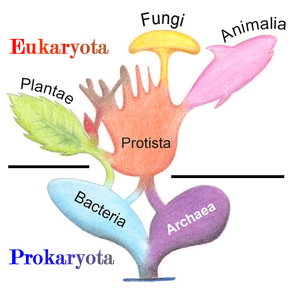
과거의 종들은 또한 그들의 진화 역사에 대한 기록을 남겼다. 화석은 현재 유기체의 비교 해부학과 함께 형태 학적 또는 해부학 적 기록을 구성한다.[16]현대 종과 멸종 된 종의 해부학을 비교함으로써 고생물학자들은 그 종의 혈통을 추론 할 수 있다. 그러나 이 접근법은 껍질, 뼈 또는 치아와 같은 단단한 신체 부위를 가진 유기체에 가장 성공적이다. 또한, 박테리아 및 고세균과 같은 원핵생물은 제한된 공통 형태를 공유하기 때문에, 그들의 화석은 그들의 조상에 대한 정보를 제공하지 않는다.
원핵 생물은 약 3-4 억 년 전부터 지구에 거주했다.[17][18] 형태학이나 세포 조직의 명백한 변화는 향후 수십억 년 동안이 유기체에서 발생하지 않았다.[19] 진핵 세포는 1.6 억 년에서 2.7 억 년 전에 나타났습니다. 세포 구조의 다음 주요 변화는 박테리아가 진핵 세포에 의해 삼켜 졌을 때, 내부공생이라고 불리는 협동 조합을 통해 이루어졌다.[20][21] 그 후 삼켜진 박테리아와 숙주 세포는 공진화를 거쳤고, 박테리아는 미토콘드리아나 하이드로게노좀으로 진화했다.[22] 남세균 같은 유기체의 또 다른 삼킴은 조류와 식물에서 엽록체의 형성으로 이어졌다.[23]
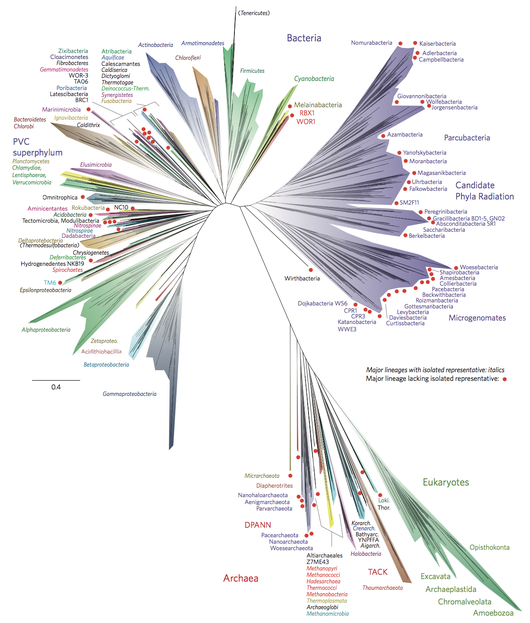
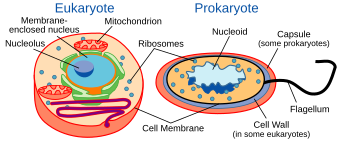
생명의 역사는 단세포 원핵생물과 진핵생물의 역사였고, 약 6억 1천만년 전 에디아카라기 시대에 다세포 생물이 바다에 나타나기 시작했다.[17][25] 다세포성의 진화는 해면동물, 갈조류, 남세균, 점균류 와 점액세균 같은 다양한 생물에서 여러 독립적인 사건들에서 일어났다.[26]
2016년에 과학자들은 약 8억년 전에 GK-PID라고 불리는 단일 분자의 작은 유전적 변화가 유기체가 단일 세포 유기체에서 많은 세포 중 하나로 갈 수 있게 했을지도 모른다고 보고했다.[27]
이러한 최초의 다세포 생물이 출현한 직후, 캄브리아기 폭발이라고 불리는 사건으로, 약 1천만년에 걸쳐 놀라운 양의 생물학적 다양성이 나타났다. 여기서, 대부분의 종류의 현대 동물들이 화석 기록에 등장했고, 그 후에 멸종된 독특한 계통도 나타났다.[28]
캄브리아기의 폭발은 광합성으로 인한 대기 중 산소의 축적을 포함하여 다양한 계기가 제안되었다.[29]
배경
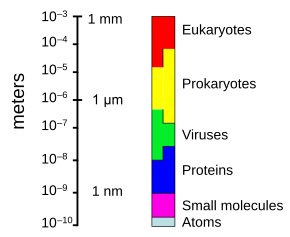
원핵생물과 진핵생물의 어원은 그리스어로 프로는 "전"을, eu는 "진짜" 또는 "참"을, karyon은 "넛", "커널" 또는 "핵"을 의미한다.[30][31][32] 그래서 원핵생물은 "핵보다 먼저"를 의미하고 진핵생물은 "진정한 핵"을 의미한다.
원핵생물과 진핵생물의 생물 형태 분리는 미생물학자 로저 스타니에와 C. B. 반 니엘에 의해 1962년 논문에서 확고하게 확립되었다.[33] 이러한 분류의 한 가지 이유는 당시 청록조류(현재는 청록조류)라고 불리던 것이 식물로 분류되지 않고 박테리아로 분류되기 때문이다.
1990년에 칼 우즈 등은 3-도메인 시스템을 도입했다.[34][35] 원핵생물은 고세균과 박테리아의 두 영역으로 나뉘어졌고, 진핵생물은 그 자체로 하나의 도메인이 되었다. 이전 분류와의 주요 차이점은 박테리아에서 고세균을 분리하는 것이다.

지구상의 생명체에 대한 가장 초기의 증거는 37억 년 된 암석에서 발견된 생명 발생 탄소와 스트로마톨라이트 화석에서 나온다. [36][37]
2015년, 41억 년 된 암석들에서 가능한 "생물학적 생명의 잔해"가 발견되었다.[38][39] 2017년 지구상에서 가장 오래된 형태의 생명체에 대한 추정 적 증거는 4.28 억 년 전, 4.4 억 년 전에 바다가 형성 된 지 얼마 지나지 않아 4.54 억 년 전에 지구가 형성 된 지 얼마 지나지 않아 열수 분출공 침전물에서 발견 된 화석화 된 미생물의 형태로 보고 되었다. [40][41]
공존하는 박테리아와 고세균의 미생물 매트는 초기 시생누대에서 지배적 인 형태의 생명체였으며 초기 진화의 많은 주요 단계가 이 환경에서 일어난 것으로 생각된다. [42]
약 3.5 Ga의 광합성의 진화는 대기 중에 폐제품 산소의 축적을 초래하여 약 2.4 Ga에서 시작된 산소 대폭발 사건으로 이어졌다.[43]
진핵생물의 가장 오래된 증거는 1.85 Ga이며,[44][45] 그리고 그들이 더 일찍 존재했을 수도 있지만, 물질대사에 산소를 사용하기 시작했을 때 그들의 다양 화가 가속화되었습니다. 나중에, 약 1.7 Ga, 분화 세포가 전문화 된 기능을 수행하는 다세포 생물가 나타나기 시작했다.[46]
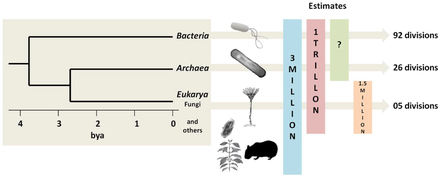
원핵생물을 포함한 공기 중에 떠다니는 미생물의 흐름은 기상 시스템 위지만 상업용 항공로 아래를 돌고 있다.[50]
일부 이동해다니는 미생물은 육상 먼지 폭풍에서 휩쓸려 가지만, 대부분은 바다 비말의 해양 미생물에서 비롯된다. 2018년에 과학자들은 수억 개의 바이러스와 수천만 개의 박테리아가 지구 전역의 모든 평방 미터에 매일 퇴적된다고 보고했다. [51][52]
해저 미시적 인 생물은 다양하며 해양 생태계에서 바이러스의 역할과 같이 여전히 잘 이해되지 않는다. [53]
대부분의 해양 바이러스는 박테리오파지로 식물과 동물에게는 무해하지만 바닷물과 담수 생태계의 규제에 필수적이다.[54]
그들은 수생 미생물 공동체에서 박테리아와 고세균을 감염시키고 파괴하며 해양 환경에서탄소를 재활용하는 것은 가장 중요한 메커니즘이며, 죽은 박테리아 세포에서 방출 된 유기 분자는 신선한 박테리아와 조류 성장을 자극한다.[55]
바이러스 활성은 또한 생물학적 펌프에 기여할 수 있으며, 탄소가 심해에서 격리되는 과정이다. [56]
해양세균(Marine Bacteria)

세균은 원핵생물역의 상당한 부분을 차지한다. 일반적으로 몇 마이크로미터 정도의 길이를 가진 세균들은 구형, 막대형, 나선형의 다양한 모양을 가진다. 세균은 지구에서 출현한 최초의 생명체 중 하나이고 지구상의 모든 환경에서 서식한다. 세균은 토양이나 물속, 산성을 띄는 온천, 방사성 폐기물, 그리고 깊은 땅속에도 서식한다. 또한 세균은 동식물과 공생하거나 기생하며 살기도 한다.
세균은 한때 분열균(Schizomycete)을 구성하는 식물로 여겨졌었지만 현재는 원핵생물로 분류된다. 동물이나 진핵생물의 세포와는 달리, 세균은 핵을 가지고 있지 않으며, 막성 세포소기관을 가지고 있는 경우도 거의 없다. 과거에 세균은 모든 원핵생물을 포함하는 용어였으나, 1990년대에 원핵생물이 고대의 공통 조상으로부터 진화하였지만 매우 다른 두 가지 유형의 유기체로 구성되어있다는 사실이 발견되면서 과학적인 분류가 변화하였다. 이 두 가지 진화의 영역을 세균과 고균이라 한다.
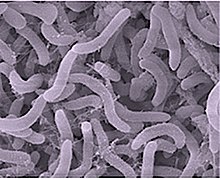
현재 존재하는 세균의 조상은 약 40억년 전 지구에 나타난 최초의 생명체인 단세포 미생물이다. 약 30억년 동안, 대부분의 유기체들은 현미경으로 보아야만 볼 수 있을 정도로 작았고, 이러한 생명체들 중 지배적이었던 것이 바로 세균과 고균이다. 스트로마톨라이트와 같은 세균화석이 존재하지만, 이러한 것들은 독특한 형태학적 구조가 없기 때문에 세균의 진화 역사를 조사하거나 특정 세균 종의 기원 연대를 추정하는데 사용할 수 없다. 하지만 유전자 서열을 사용하여 세균의 계통발생을 재구성할 수 있으며, 이러한 연구는 세균이 고균/진핵생물 계통에서 가장 먼저 나뉘었음을 나타낸다. 또한 세균은 고균과 진핵생물의 진화적 분화에도 관여하였다. 고대의 세균이 진핵생물의 조상의 내부로 들어가 내부공생(Endosymbiosis)을 시작하면서 현재의 진핵생물이 나타나게 되었고, 이는 아마도 고균과도 관련이 있었을 것이다. 이는 현재 알려진 모든 진핵생물에서 발견되는 미토콘드리아(Mitochondria)나 하이드로게노좀(Hydrogenosome)을 형성하기 위해서 최초의 진핵생물이 알파프로테오박테리아(Alphaproteobacteria) 공생체를 삼키는 것을 포함한다. 이후에는 이미 미토콘드리아를 포함하고 있던 일부 진핵생물들도 남세균(Cyanobacteria) 유사한 유기체를 삼켰다. 이는 조류(Algae)와 식물에서 엽록체(Chloroplast)를 형성하도록 하였다. 일부 조류는 훨씬 나중에 일어난 내부공생에서 유래하기도 하였다. 진핵생물들은 "2세대" 색소체(Plastid)로서 발전한 조류를 삼켰는데 이를 2차 내부공생이라 한다.
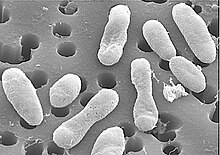
세균은 일정한 크기로 자라면 무성생식(Asexual reproduction)의 한 형태인 이분법(Binary fission)을 통해 번식한다. 최적의 환경 하에서 세균은 매우 빠르게 성장하고 분열할 수 있으며, 세균의 개체수는 9.8분마다 2배가 될 수 있다.
펠라지박터 유퀴비(Pelagibacter ubique)와 그 근연종은 바다에서 가장 풍부한 미생물이면서, 세계에서 가장 풍부한 세균일 것이라 여겨져 왔다. 이들은 전체 미생물 플랑크톤의 약 25%를 차지하며, 여름에는 온대 해양 표면에 존재하는 미생물의 절반 정도를 차지한다. 펠라지박터 유퀴비와 그 근연종의 총량은 2 × 1028 정도의 양의 미생물로 추정된다. 하지만 2013년 2월 네이처(Nature)에는 펠라지박터 유퀴비를 공격하는 박테리오파지인 HTV010P가 발견되었으며, 이것이 지구상에서 가장 흔한 유기체일 것이라고 보고되었다.
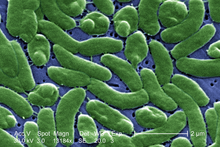
로제오박터(Roseobacter) 또한 바다에서 가장 풍부한 미생물 중 하나이다. 탁 트인 연안, 해빙, 해저 등 다양한 해양 서식지에서 서식하며, 연안의 해양세균의 약 25%를 차지한다. 로제오박터 속을 구성하는 그룹은 생물지화학순환(Biogeochemical cycle)과 기후변화에 대해서 중요한 역할을 하며, 해양 환경에서 지구의 탄소 중 상당 부분을 처리한다. 로제오박터는 방향족 화합물(Aromatic compounds)을 분해하고 미량 금속을 흡수하는 공생 관계를 형성한다. 로제오박터는 양식(Aquaculture)과 정족수 감지(Quorum sensing)에서 널리 사용된다. 조류 대발생(Algal blooms) 기간에 발생하는 원핵생물 군락의 20-30%가 로제오박터이다.
현재 알려진 세균 중 가장 큰 해양의 티오마르가리타 나미비엔시스(Thiomargarita namibiensis)는 육안으로도 볼 수 있으며 때로는 0.75mm(750 μm)에 이른다.


남세균(Cyanobacteria)
남세균은 햇빛을 화학 에너지로 바꾸는 능력을 진화시킨 최초의 유기체이다. 남세균은 단세포 세균에서 사상성 세균(Filamentous bacteria)까지 다양하며 군집종을 포함하는 문(Phylum)을 형성한다. 습지, 담수 및 해양 환경, 남극의 암석 등 지구상의 거의 모든 곳에서 발견된다. 특히, 식물성 플랑크톤처럼 어떤 종들은 바다에 떠다니기도 한다. 최초로 광합성을 시작한 생산자는 약 23억년 전의 해양 남세균이었다. 남세균의 광합성에 의한 산물인 산소 분자의 방출은 지구 환경의 변화를 유도하였다. 당시 지구상의 대부분의 생명체에게는 산소가 독성이었기 때문에 산소에 내성이 없던 유기체들은 거의 멸종 위기에 처하게 되었고, 이것은 주요 동식물의 진화 방향을 바꾸는 엄청난 변화를 가져왔다.
1986년에 발견된 0.6 µm정도의 아주 작은 크기의 해양 남세균인 프로클로로코커스(Prochlorococcus)는 오늘날 해양 먹이사슬에서 중요한 기초를 형성하고 있으며, 외해의 광합성 대부분과 지구 대기 중 산소의 20%를 생산한다고 추정된다. 이 세균은 표면 해수 1mL 당 100,000개 이상 존재하여 아마도 지구상에서 가장 풍부한 속(Genus)일 것이라 생각된다.
원래 생물학자들은 남세균을 조류로 분류하여 남조류(Blue-green algae)라고 불렀다. 최근에는 남세균은 세균이며 조류(Algae)와 함께 분류되지 않는다고 여겨진다. 대부분의 학자들은 모든 원핵생물을 조류(Algae)로부터 제외시켰고 이에따라 남세균 또한 조류에서 제외되었다.
그 외의 세균들
남세균을 제외한 다른 해양세균들도 아주 흔하며 해양에서 중요한 역할을 할 수 있다. 여기에는 코피오트로프(Copiotroph), 알테로모나스 마클레오디이(Alteromonas macleodii)가 포함된다.
각주
- ↑ Youngson RM (2006). Collins Dictionary of Human Biology. Glasgow: HarperCollins. ISBN 978-0-00-722134-9.
- ↑ Nelson DL, Cox MM (2005). Lehninger Principles of Biochemistry (4th ed.). New York: W.H. Freeman. ISBN 978-0-7167-4339-2.
- ↑ Martin EA, ed. (1983). Macmillan Dictionary of Life Sciences (2nd ed.). London: Macmillan Press. ISBN 978-0-333-34867-3.
- ↑ Fuerst JA (2010). "Beyond Prokaryotes and Eukaryotes: Planctomycetes and Cell Organization". Nature Education. 3 (9): 44.
- ↑ 2002 WHO mortality data Accessed 20 January 2007
- ↑ University of Georgia (10 December 2015). "Functions of global ocean microbiome key to understanding environmental changes". www.sciencedaily.com. Retrieved 11 December 2015.
- ↑ Bar-On YM, Phillips R, Milo R (2018). "The biomass distribution on Earth" (PDF). Proceedings of the National Academy of Sciences of the United States of America. 115 (25): 6506–6511. Bibcode:1998PNAS...95.6578W. doi:10.1073/pnas.1711842115. PMC 6016768. PMID 29784790.
- ↑ Doglioni C, Pignatti J, Coleman M (2016). "Why did life develop on the surface of the Earth in the Cambrian?". Geoscience Frontiers. 7 (6): 865–873. doi:10.1016/j.gsf.2016.02.001.
- ↑ “Age of the Earth”. United States Geological Survey. 2007년 7월 9일. 2015년 5월 31일에 확인함.
- ↑ Dalrymple 2001, 205–221쪽
- ↑ Manhesa, Gérard; Allègre, Claude J.; Dupréa, Bernard; Hamelin, Bruno (May 1980). “Lead isotope study of basic-ultrabasic layered complexes: Speculations about the age of the earth and primitive mantle characteristics”. 《Earth and Planetary Science Letters》 47 (3): 370–382. Bibcode:1980E&PSL..47..370M. doi:10.1016/0012-821X(80)90024-2.
- ↑ Schopf, J. William; Kudryavtsev, Anatoliy B.; Czaja, Andrew D.; Tripathi, Abhishek B. (2007년 10월 5일). “Evidence of Archean life: Stromatolites and microfossils”. 《Precambrian Research》 158 (3–4): 141–155. Bibcode:2007PreR..158..141S. doi:10.1016/j.precamres.2007.04.009.
- ↑ Raven & Johnson 2002, 68쪽
- ↑ Baumgartner, R. J.; 외. (2019). “Nano−porous pyrite and organic matter in 3.5-billion-year-old stromatolites record primordial life” (PDF). 《Geology》 47 (11): 1039–1043. Bibcode:2019Geo....47.1039B. doi:10.1130/G46365.1. S2CID 204258554.
- ↑ Earliest signs of life: Scientists find microbial remains in ancient rocks Phys.org. 26 September 2019.
- ↑ Jablonski, David (1999년 6월 25일). “The Future of the Fossil Record”. 《Science》 284 (5423): 2114–2116. doi:10.1126/science.284.5423.2114. PMID 10381868. S2CID 43388925.
- ↑ 가 나 Cavalier-Smith, Thomas (2006년 6월 29일). “Cell evolution and Earth history: stasis and revolution”. 《Philosophical Transactions of the Royal Society B: Biological Sciences》 361 (1470): 969–1006. doi:10.1098/rstb.2006.1842. PMC 1578732. PMID 16754610.
- ↑ Schopf, J. William (2006년 6월 29일). “Fossil evidence of Archaean life”. 《Philosophical Transactions of the Royal Society B: Biological Sciences》 361 (1470): 869–885. doi:10.1098/rstb.2006.1834. PMC 1578735. PMID 16754604.
- Altermann, Wladyslaw; Kazmierczak, Józef (November 2003). “Archean microfossils: a reappraisal of early life on Earth”. 《Research in Microbiology》 154 (9): 611–617. doi:10.1016/j.resmic.2003.08.006. PMID 14596897.
- ↑ Schopf, J. William (1994년 7월 19일). “Disparate rates, differing fates: tempo and mode of evolution changed from the Precambrian to the Phanerozoic”. 《Proceedings of the National Academy of Sciences of the United States of America》 91 (15): 6735–6742. Bibcode:1994PNAS...91.6735S. doi:10.1073/pnas.91.15.6735. PMC 44277. PMID 8041691.
- ↑ Poole, Anthony M.; Penny, David (January 2007). “Evaluating hypotheses for the origin of eukaryotes”. 《BioEssays》 29 (1): 74–84. doi:10.1002/bies.20516. PMID 17187354.
- ↑ Dyall, Sabrina D.; Brown, Mark T.; Johnson, Patricia J. (2004년 4월 9일). “Ancient Invasions: From Endosymbionts to Organelles”. 《Science》 304 (5668): 253–257. Bibcode:2004Sci...304..253D. doi:10.1126/science.1094884. PMID 15073369. S2CID 19424594.
- ↑ Martin, William (October 2005). “The missing link between hydrogenosomes and mitochondria”. 《Trends in Microbiology》 13 (10): 457–459. doi:10.1016/j.tim.2005.08.005. PMID 16109488.
- ↑ Lang, B. Franz; Gray, Michael W.; Burger, Gertraud (December 1999). “Mitochondrial genome evolution and the origin of eukaryotes”. 《Annual Review of Genetics》 33: 351–397. doi:10.1146/annurev.genet.33.1.351. PMID 10690412.
- McFadden, Geoffrey Ian (1999년 12월 1일). “Endosymbiosis and evolution of the plant cell”. 《Current Opinion in Plant Biology》 2 (6): 513–519. doi:10.1016/S1369-5266(99)00025-4. PMID 10607659.
- ↑ Hug, Laura A.; Baker, Brett J.; Anantharaman, Karthik; Brown, Christopher T.; Probst, Alexander J.; Castelle, Cindy J.; Butterfield, Cristina N.; Hernsdorf, Alex W.; Amano, Yuki; Ise, Kotaro; Suzuki, Yohey (2016년 4월 11일). “A new view of the tree of life”. 《Nature Microbiology》 (영어) 1 (5): 16048. doi:10.1038/nmicrobiol.2016.48. ISSN 2058-5276. PMID 27572647.
- ↑ DeLong, Edward F.; Pace, Norman R. (2001년 8월 1일). “Environmental Diversity of Bacteria and Archaea”. 《Systematic Biology》 50 (4): 470–478. CiteSeerX 10.1.1.321.8828. doi:10.1080/106351501750435040. PMID 12116647.
- ↑ Kaiser, Dale (December 2001). “Building a multicellular organism”. 《Annual Review of Genetics》 35: 103–123. doi:10.1146/annurev.genet.35.102401.090145. PMID 11700279. S2CID 18276422.
- ↑ Zimmer, Carl (2016년 1월 7일). “Genetic Flip Helped Organisms Go From One Cell to Many”. 《The New York Times》. 2016년 1월 7일에 확인함.
- ↑ Valentine, James W.; Jablonski, David; Erwin, Douglas H. (1999년 3월 1일). “Fossils, molecules and embryos: new perspectives on the Cambrian explosion” (PDF). 《Development》 126 (5): 851–859. doi:10.1242/dev.126.5.851. PMID 9927587. 2014년 12월 30일에 확인함.
- ↑ Ohno, Susumu (January 1997). “The reason for as well as the consequence of the Cambrian explosion in animal evolution”. 《Journal of Molecular Evolution》 44 (Suppl. 1): S23–S27. Bibcode:1997JMolE..44S..23O. doi:10.1007/PL00000055. PMID 9071008. S2CID 21879320.
- Valentine, James W.; Jablonski, David (2003). “Morphological and developmental macroevolution: a paleontological perspective”. 《The International Journal of Developmental Biology》 47 (7–8): 517–522. PMID 14756327. 2014년 12월 30일에 확인함.
- ↑ Campbell, N. "Biology:Concepts & Connections". Pearson Education. San Francisco: 2003.
- ↑ 하퍼, 더글러스. “prokaryote”. 《온라인 어원 사전》.
- ↑ 하퍼, 더글러스. “eukaryotic”. 《온라인 어원 사전》.
- ↑ Stanier RY, Van Niel CB (1962). “The concept of a bacterium”. 《Archiv für Mikrobiologie》 42: 17–35. doi:10.1007/BF00425185. PMID 13916221. S2CID 29859498.
- ↑ Woese CR, Fox GE (November 1977). “Phylogenetic structure of the prokaryotic domain: the primary kingdoms”. 《Proceedings of the National Academy of Sciences of the United States of America》 74 (11): 5088–90. Bibcode:1977PNAS...74.5088W. doi:10.1073/pnas.74.11.5088. PMC 432104. PMID 270744.
- ↑ Woese CR, Kandler O, Wheelis ML (June 1990). “Towards a natural system of organisms: proposal for the domains Archaea, Bacteria, and Eucarya”. 《Proceedings of the National Academy of Sciences of the United States of America》 87 (12): 4576–9. Bibcode:1990PNAS...87.4576W. doi:10.1073/pnas.87.12.4576. PMC 54159. PMID 2112744.
- ↑ Ohtomo, Yoko; Kakegawa, Takeshi; Ishida, Akizumi; Nagase, Toshiro; Rosing, Minik T. (January 2014). “Evidence for biogenic graphite in early Archaean Isua metasedimentary rocks”. 《Nature Geoscience》 (영어) 7 (1): 25–28. Bibcode:2014NatGe...7...25O. doi:10.1038/ngeo2025.
- ↑ Nutman, Allen P.; Bennett, Vickie C.; Friend, Clark R. L.; Kranendonk, Martin J. Van; Chivas, Allan R. (September 2016). “Rapid emergence of life shown by discovery of 3,700-million-year-old microbial structures”. 《Nature》 (영어) 537 (7621): 535–538. Bibcode:2016Natur.537..535N. doi:10.1038/nature19355. PMID 27580034. S2CID 205250494.
- ↑ Borenstein, Seth (2015년 10월 19일). “Hints of life on what was thought to be desolate early Earth”. 《Excite》 (Yonkers, NY: Mindspark Interactive Network). Associated Press. 2015년 10월 23일에 원본 문서에서 보존된 문서. 2018년 10월 8일에 확인함.
- ↑ Bell, Elizabeth A.; Boehnike, Patrick; Harrison, T. Mark; 외. (2015년 10월 19일). “Potentially biogenic carbon preserved in a 4.1 billion-year-old zircon”. 《Proc. Natl. Acad. Sci. U.S.A.》 112 (47): 14518–21. Bibcode:2015PNAS..11214518B. doi:10.1073/pnas.1517557112. PMC 4664351. PMID 26483481.
- ↑ Dodd, Matthew S.; Papineau, Dominic; Grenne, Tor; slack, John F.; Rittner, Martin; Pirajno, Franco; O'Neil, Jonathan; Little, Crispin T. S. (2017년 3월 2일). “Evidence for early life in Earth's oldest hydrothermal vent precipitates” (PDF). 《Nature》 543 (7643): 60–64. Bibcode:2017Natur.543...60D. doi:10.1038/nature21377. PMID 28252057. S2CID 2420384.
- ↑ Zimmer, Carl (2017년 3월 1일). “Scientists Say Canadian Bacteria Fossils May Be Earth's Oldest”. 《The New York Times》. 2017년 3월 2일에 확인함.
- ↑ Nisbet, Euan G.; Fowler, C. M. R. (1999년 12월 7일). “Archaean metabolic evolution of microbial mats”. 《Proceedings of the Royal Society of London B》 266 (1436): 2375–2382. doi:10.1098/rspb.1999.0934. PMC 1690475.
- ↑ Anbar, Ariel D.; Yun Duan; Lyons, Timothy W.; 외. (2007년 9월 28일). “A Whiff of Oxygen Before the Great Oxidation Event?”. 《Science》 317 (5846): 1903–1906. Bibcode:2007Sci...317.1903A. doi:10.1126/science.1140325. PMID 17901330. S2CID 25260892.
- ↑ Knoll, Andrew H.; Javaux, Emmanuelle J.; Hewitt, David; Cohen, Phoebe (2006년 6월 29일). “Eukaryotic organisms in Proterozoic oceans”. 《Philosophical Transactions of the Royal Society B》 361 (1470): 1023–1038. doi:10.1098/rstb.2006.1843. PMC 1578724. PMID 16754612.
- ↑ Fedonkin, Mikhail A. (2003년 3월 31일). “The origin of the Metazoa in the light of the Proterozoic fossil record” (PDF). 《Paleontological Research》 7 (1): 9–41. doi:10.2517/prpsj.7.9. S2CID 55178329. 2009년 2월 26일에 원본 문서 (PDF)에서 보존된 문서. 2008년 9월 2일에 확인함.
- ↑ Bonner, John Tyler (1998). “The origins of multicellularity”. 《Integrative Biology》 1 (1): 27–36. doi:10.1002/(SICI)1520-6602(1998)1:1<27::AID-INBI4>3.0.CO;2-6.
- ↑ May, R.M. (1988) "How many species are there on earth?". Science, 241(4872): 1441–1449. doi 10.1126/science.241.4872.1441.
- ↑ Locey, K.J. and Lennon, J.T. (2016) "Scaling laws predict global microbial diversity". Proceedings of the National Academy of Sciences, 113(21): 5970–5975. doi 10.1073/pnas.1521291113.
- ↑ Vitorino, L.C. and Bessa, L.A. (2018) "Microbial diversity: the gap between the estimated and the known". Diversity, 10(2): 46. doi 10.3390/d10020046.
 Modified text was copied from this source, which is available under a Creative Commons Attribution 4.0 International License.
Modified text was copied from this source, which is available under a Creative Commons Attribution 4.0 International License.
- ↑ Living Bacteria Are Riding Earth’s Air Currents Smithsonian Magazine, 11 January 2016.
- ↑ Robbins, Jim (2018년 4월 13일). “Trillions Upon Trillions of Viruses Fall From the Sky Each Day”. 《The New York Times》. 2018년 4월 14일에 확인함.
- ↑ Reche, Isabel; D’Orta, Gaetano; Mladenov, Natalie; Winget, Danielle M; Suttle, Curtis A (2018년 1월 29일). “Deposition rates of viruses and bacteria above the atmospheric boundary layer”. 《ISME Journal》 12 (4): 1154–1162. doi:10.1038/s41396-017-0042-4. PMC 5864199. PMID 29379178.
- ↑ Suttle, C.A. (2005). “Viruses in the Sea”. 《Nature》 437 (9): 356–361. Bibcode:2005Natur.437..356S. doi:10.1038/nature04160. PMID 16163346. S2CID 4370363.
- ↑ Shors 2017, 5쪽
- ↑ Shors 2017, 593쪽
- ↑ Suttle CA (2007). “Marine viruses—major players in the global ecosystem”. 《Nature Reviews Microbiology》 5 (10): 801–12. doi:10.1038/nrmicro1750. PMID 17853907. S2CID 4658457.

